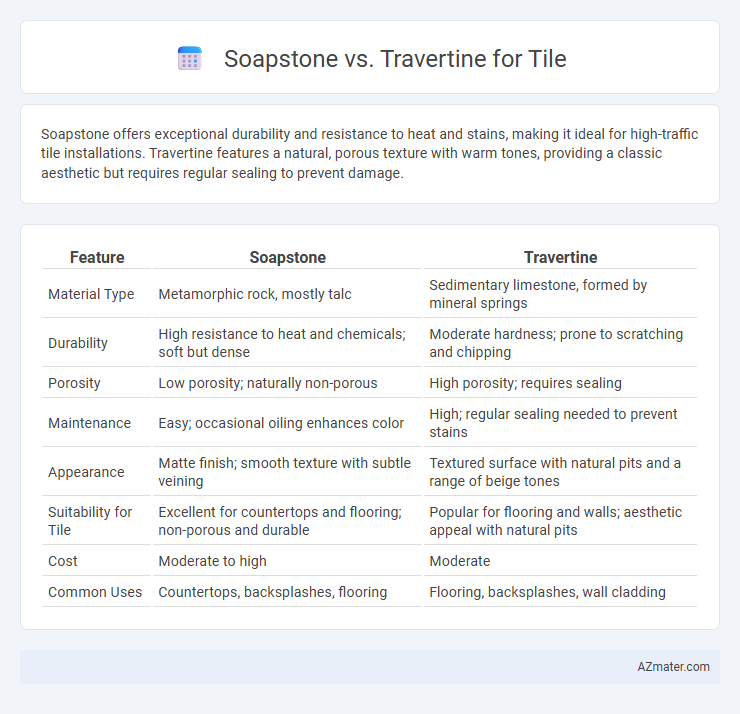Soapstone offers exceptional durability and resistance to heat and stains, making it ideal for high-traffic tile installations. Travertine features a natural, porous texture with warm tones, providing a classic aesthetic but requires regular sealing to prevent damage.
Table of Comparison
| Feature | Soapstone | Travertine |
|---|---|---|
| Material Type | Metamorphic rock, mostly talc | Sedimentary limestone, formed by mineral springs |
| Durability | High resistance to heat and chemicals; soft but dense | Moderate hardness; prone to scratching and chipping |
| Porosity | Low porosity; naturally non-porous | High porosity; requires sealing |
| Maintenance | Easy; occasional oiling enhances color | High; regular sealing needed to prevent stains |
| Appearance | Matte finish; smooth texture with subtle veining | Textured surface with natural pits and a range of beige tones |
| Suitability for Tile | Excellent for countertops and flooring; non-porous and durable | Popular for flooring and walls; aesthetic appeal with natural pits |
| Cost | Moderate to high | Moderate |
| Common Uses | Countertops, backsplashes, flooring | Flooring, backsplashes, wall cladding |
Introduction to Soapstone and Travertine Tiles
Soapstone tiles are composed primarily of talc and magnesium silicate, offering a soft, matte finish that resists stains and heat, making them ideal for kitchens and bathrooms. Travertine tiles, a form of limestone deposited by mineral springs, feature natural pores and a warm, textured surface, often used in flooring and wall cladding for a rustic or classic look. Both materials provide durable, natural stone options with distinct aesthetics and maintenance requirements, suitable for various interior design styles.
Key Differences in Appearance
Soapstone tiles feature a smooth, matte surface with subtle veining in shades of gray and green, providing a natural, rustic appeal. Travertine tiles display a more textured, porous surface with distinct pits and veins, usually in warm tones like beige, cream, and rust. The uniformity and muted colors of soapstone contrast sharply with travertine's varied, earthy patterns and more polished finish.
Durability and Hardness Comparison
Soapstone exhibits a Mohs hardness of 1 to 2.5, making it relatively soft and prone to scratching but highly resistant to heat and chemical stains. Travertine rates around 3 to 4 on the Mohs scale, offering greater hardness and durability with increased resistance to impact and wear, though it can be porous and may require sealing to prevent staining. For tile applications, travertine is generally more durable and better suited for high-traffic areas, while soapstone provides easier maintenance and superior heat resistance.
Maintenance and Cleaning Requirements
Soapstone tiles require minimal maintenance due to their non-porous surface, resisting stains and water damage without the need for sealing. Travertine tiles, being porous, necessitate regular sealing to prevent staining and damage from moisture exposure. Cleaning soapstone involves mild soap and water, while travertine requires pH-neutral cleaners to avoid etching and preserve its natural finish.
Water and Stain Resistance
Soapstone demonstrates superior water resistance due to its dense, non-porous structure, which effectively repels moisture and reduces the risk of staining. Travertine, a porous natural stone, requires sealing to enhance its water and stain resistance, as its open pits and voids can absorb liquids and develop stains over time. For high-moisture areas or spaces prone to spills, soapstone offers a more durable and low-maintenance tile option compared to travertine.
Installation Considerations
Soapstone tiles require minimal sealing and are relatively easy to cut and shape, making installation straightforward, especially for DIY projects. Travertine tiles demand more precise handling due to their porous nature, requiring sealing before and after installation to prevent staining and moisture damage. Both materials benefit from using a high-quality adhesive compatible with natural stone to ensure a secure and long-lasting tile installation.
Cost Comparison: Soapstone vs Travertine
Soapstone tiles generally cost between $10 and $20 per square foot, reflecting their durability and unique matte finish, while travertine tiles typically range from $5 to $15 per square foot, offering a more budget-friendly yet elegant option with natural veining. Installation costs for soapstone tend to be higher due to its density and weight, often requiring specialized cutting tools and labor, whereas travertine installation is usually less expensive and faster, benefiting from its softer composition. Maintenance expenses also differ; soapstone demands less frequent sealing compared to travertine, which requires routine sealing to prevent staining and damage, influencing long-term cost considerations.
Best Uses and Applications
Soapstone tiles offer superior resistance to heat and stains, making them ideal for kitchen countertops, backsplashes, and fireplace surrounds, where durability and low maintenance are crucial. Travertine tiles, prized for their natural pores and textured surface, are best used in bathrooms, patios, and indoor flooring applications that benefit from slip resistance and aesthetic warmth. Both stones perform well in residential settings but choosing Soapstone ensures longevity in high-traffic or high-moisture areas, while Travertine enhances design with its classic, earthy tones.
Environmental Impact and Sourcing
Soapstone is a natural metamorphic rock primarily composed of talc, making it softer and easier to quarry with less energy consumption compared to the sedimentary travertine, which forms from mineral deposits in hot springs and requires extensive mining. The environmental impact of soapstone tile is generally lower due to its abundance and less intensive processing, while travertine extraction often involves significant land disturbance and higher carbon emissions. Sustainable sourcing practices for both materials are critical, but soapstone's durability and recyclability provide a more eco-friendly option for long-term use in tiling.
Pros and Cons Summary
Soapstone offers excellent durability and resistance to heat and stains, making it ideal for kitchen countertops and tiles in high-traffic areas. Travertine provides a classic, elegant appearance with natural variations and a warm color palette, but it is more porous and requires regular sealing to prevent staining and damage. Soapstone's soft texture can scratch more easily, while travertine's tendency to chip and erode makes it less suitable for heavy-use environments.

Infographic: Soapstone vs Travertine for Tile
 azmater.com
azmater.com